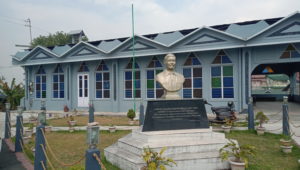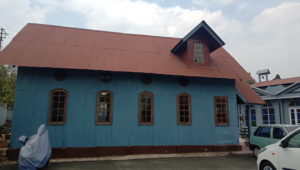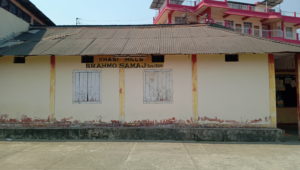The social reform movements of nineteenth century Bengal spread in North East India as well. The Brahmo Samaj was one such movement. Following the formation of the Chief Commissionership of Assam in 1874, Brahmo influence grew in the Khasi Hills.
The initial number of Brahmos in the Khasi Hills was numbered around 25 and most of them worked under the British Raj, having migrated from Sylhet and neighbouring districts in Bengal.
Prominent people in Shillong worked together to bring about change. Among them, Shibnath Dutta, Brojendranath Sen, Hajom Kissor Singh Nongbri, Radhon Singh Berry, Job Solomon and Babu Jeebon Roy were instrumental in changing the cultural landscape of the capital.

Roots of Brahmoism
The Khasi Mission was established to work with the Khasi people in and around Shillong. Rev Nilmoni Chakraborty was appointed by the Sadharan Brahmo Samaj in Calcutta. He found himself in Cherrapunjee and remained there for a long time, immersing himself in education and homeopathy.
Two men were instrumental in building the Brahmo prayer hall in Police Bazar – Bidhan Chandra Roy and Maharishi Debendranath Tagore. It is said that the Brahmos approached Tagore for financial help in 1874. The Mawkhar Brahmo Samaj was established in the same year with the money he gave. Radhon Singh Berry, a Khasi Brahmo was said to have negotiated with the Syiem of Mylliem for land and the Mawkhar hall was set up with his initiative. Job Solomon, another Khasi Brahmo, worked closely with Berry.
Both were also active with the Unitarian Movement in the Khasi Hills. Radhon Singh, also a Seng Khasi man wrote more than 30 hymns for their hymn book, and converted to Unitarianism later. Job Solomon was also associated with Presbyterianism. Babu Jeebon Roy took an active interest in the Brahmo activity and provided much needed assistance.
The Khasi Brahmo Samaj hall in Laban were shaped by Rash Chandra Choudhury and his wife, Hemanta Kumari Choudhurani.
Rukma Sen, a resident of Shillong and wife of late Raja Sen, who came from a Brahmo family, said, “The Khasi Hills Brahmo Samaj at Laban was more active, compared to Police Bazar. Madan Laban was called Brahmo Palli as Brahmos in Shillong lived in this locality.”
Brahmo ladies of Shillong were heavily into social work and education. Noted women educationists like Subarna Prabha Das, Sarada Manjari Dutta, Sushila Sen and Leela Roy set up schools. Jail Road Girls School, Laban Bengali Girls School and Lady Keane School and College became premier institutions with particular focus on women’s education.
Mahila Samities had come up in Jail Road. Rammohan Mahila Samity and a library were run by the ladies of the Khasi Brahmo Samaj. They focused on vocational education. Knitting machines, for example, opened self-employment avenues.They launched a movement to close liquor dens in Laban. Prominent Brahmo Khasi women were U Dori Roy of Nongjri, U Ibis Mohon Roy of Sohbar and Kong Helimon Khongpai. Kong Helimon went to Dacca and Calcutta for her higher studies and remained a close associate of the Brahmo Samaj, long after she retired from service.
Libraries were also set up in Shillong – The Ram Mohan Library at Laban and the Tagore Memorial Library in Police bazar – were well known for its collection of books.

Brahmo – Unitarianism Approach
The Brahmos shared a close relationship with the Unitarian Church in the Khasi Hills. The founder, Hajom Kissor Singh Nongbri shared a close relationship with Rev Nilmoni Chakraborty, who worked in both Sohra and Shillong. In his autobiography, written in Bengali, the Rev spoke of the Khasi people, highlighting the close ties between Bengal and the Khasi Hills.
Unitarianism came to the Hills on September 18, 1887, with the first church established at Jowai. The founder was influenced by the Brahmo philosophy. Born in Sohra in 1865, he came to Shillong to pursue higher studies, but could not complete his education.
Although a convert to Christianity, he was keenly interested in knowing about other religions. Kong Battinora Rani, a member of the Unitarian Church and the great – grand-daughter of HK Singh spoke of how he regularly corresponded with his Brahmo friends and got to know of Unitarian ministers in Calcutta.
One such minister was Charles Henry Appleton Dall (1816 – 1886) who worked with and later joined the Brahmo Samaj in Calcutta. Through his efforts in Calcutta, the young elite stepped outside the orthodox Bengali society of the time. Unitarianism shaped the liberal outlook of the youth.
Kong Rani further stated, “He came into contact with foreign Unitarians through his Brahmo friends in Shillong. That is how the Brahmos and Unitarians are closely related in the Khasi Hills.” Many Brahmos lived in Cherrapunji, Tyrna and Nongwar, and some of them, she said, later converted to Unitarianism.
Our conversation shifted to the core philosophy of both Unitarianism and the Brahmo Samaj. Kong Rani spoke about the similarities – monotheism, acceptance of all within its fold, no idol worship and immortality of the soul – a synthesis of different spiritual/religious ideas from the world.She mentioned how both were non – proselytizing in nature. She stressed on how Unitarianism and the Brahmos were greatly influenced by each other because both viewed the other as a modern, rational approach to spirituality.This, in turn, shaped the cosmopolitan culture of nineteenth century Khasi Hills
About Hajom Kissor Singh, she said, “Neither could he remain with the Christian concept of the Holy Trinity nor could he revert back to the traditional Khasi belief of many gods/goddesses.”
Kong Battinora also remembered her childhood as we spoke. She reminisced about attending the Brahmo Sunday school at Laban. Leaders of the Unitarian Church and Brahmo Samaj were active and would attend services together, in particular, Unitarian Day.
Dr J.T. Sunderland (1832-1936), a Unitarian Minister from USA visited India during 1895-96. He was impressed with the Brahmo philosophy and came to meet the Brahmo leaders. He was the first Unitarian to visit the Khasi Hills. In his memory, the Sunderland Memorial School was built in Laban in 1941, offering classes till lower Primary. Kong Rani studied in this school. As we walked towards the school premises, she pointed towards the car parking space. “It was an old Assam type building, a single hall, where we studied.” His visit to Shillong shaped the Unitarian Movement in the Khasi Hills further.

Seng Khasi Movement
The Brahmo influence was also felt in the Seng Khasi Movement when 16 young Khasi leaders came together to fight the growing missionary activity in the Khasi Hills. Babu Jeebon Roy was not only instrumental in strengthening the Seng Khasi Movement, but he was said to be deeply influenced by the Brahmo philosophy.
Reeju Ray, historian and resident of Shillong, said, “The rejection of hierarchy, in particular, caste hierarchy, made the Brahmos different. This assertion of non-hierarchy was also seen in the Seng Khasi Movement.”
We spoke of Brahmo influence on the movement. “Anti-colonial elites came together and discussed ideas. They were local elites who were also versed in western ideas through English education. That Babu Jeebon Roy was influenced by the Brahmo ideals was seen in the roots of Khasi assertion in the late nineteenth century – that of clan lineage and protecting the distinct culture, traditions and the customary beliefs of the Khasi people or the Niam Khasi – yet, at the same time, they were liberal. He started the print culture in Khasi in the form of the Ri Khasi Press which published books on manners and clan lineage on the one hand, and Japanese rituals of murder and Gujarati crafts, on the other. Their archive has kept these records.”, Ray said.
As our conversation came to end, we spoke of how the Khasi-Brahmo connection ushered in an era of a much-needed change. Its most important contribution came in the form of a sense of community in nineteenth century Khasi Hills.



